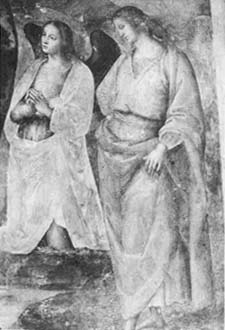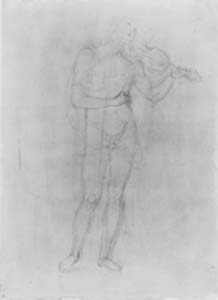
Annual Bulletin 3, 1979-1980
Home
Français
Introduction
History
Annual Index
Author &
Subject
Credits
Contact

![]()

A Re-Examination of the "Raphael"
drawing in the National Gallery of Canada
by Sylvia Ferino
Pages 1 |
2 | 3
| 4
If we compare the Ottawa youth (fig. I) with the kneeling an
gels in Perugino's fresco (fig. 6) and in the Venice sheet (fig. 4), we
can easily see a break in the drapery at knee level. This indicates that, before the Ottawa drawing was cut off at the bottom, the youth was kneeling and not standing as has been assumed so far.
In the Venice sheet the angel lacks the drapery loop above the left
forearm found in the fresco and the Ottawa drawing, and the right wing
is spread sideways and not backwards as in the fresco. In the Ottawa
sheet the wings are not visible. It was primarily this lack of wings
which prevented the youth of the Ottawa drawing from being identified with
Perugino's angel in the Foligno Baptism and which consequently
led to the attribution of the Ottawa drawing to the young Raphael.
However, even after the discovery of wings in the under-drawing
of the Ottawa figure, which I shall now discuss, the motif was wrongly
associated with the an gels in Raphael's Coronation of the Virgin in
the Vatican. (13) The subtle use of the silverpoint and the free handling
might suggest that the drawing was carried out in the course of work preparatory
to the painting and not as a copy after the painting was complete, even
though the drawing was not done from nature. And, one could argue that
the missing wings were not the artist's major concern at this stage when
he would probably have been fully occupied with the general pose of the
angel.
It is more surprising to find a drawing of the same image carried
out in brush and ink wash underneath the cream-coloured preparation of
the present silverpoint drawing (fig. 7). In an ultra-violet photograph
we can see that the image was winged in the same way as the angel in Perugino's Foligno fresco. It is modelled more carefully than the surface
drawing but the pose, outlines and the drapery are otherwise identical.
The more careful modelling gives the figure a greater vitality and emphasizes
its three-dimensional qualities. The image of the youth on top is bland
by comparison. Furthermore, the procedure of covering up a drawing in brush
and ink in order to trace over it in metal-point is quite unusual and
quite illogical.
Any attempt to explain this procedure rests on one of two basic
assumptions: either both the underdrawing and the one on top are by the
same hand, or they are the work of two different artists.
If we assume that only one artist was involved, and if we ignore
for the moment that the drawing might have been copied and redrawn by a
student as an exercise in various techniques, we must also suppose that
both layers of the drawing were done by the master also responsible for
the painting. Yet why should the master - in this case Perugino - produce
an image in one technique then cover it over and repeat it in another medium?
This question is more easily answered if we turn briefly to
a similar case: a study carried out in metal-point on a prepared surface,
in the Fogg Art Museum, of a standing male figure playing a viola (fig. 8). (14) An infra-red
photograph of the Fogg drawing reveals a chalk study
of the same figure under the grey preparation (fig. 9). (15) The differences
between the two superimposed images, in pose and in certain details of
the body, explain why the artist adopted this particular procedure. In
the chalk undersketch, the viola player is represented completely nude,
with his head tilted straight upwards in strong foreshortening very similar
to Perugino's apostles in the S Pietro altarpiece of 1496-98. (16) The forms
of the body are more articulated and the pose is more upright and concentrated
than in the top drawing. The study appears to be a sketch from nature.
In the metal-point drawing on top, the swing of the hip is emphasized,
the head is tilted sideways, and the image moves more rhythmically on the
plane. This impression is further emphasized by the slight indication
of the gracefully draped veil. The whole figure has become more gentle
and more suggestive of the act of music making.
While the artist concentrated in the first instance (the chalk
sketch) on the correct presentation of the human body in a particular pose,
he is concerned in the second drawing with the specific context in which
the figure would appear in the finished painting. (17) Instead of starting
anew, he corrected the chalk sketch in the most economic manner, using
its outlines as a basis for his new image. This method was commonly employed
by Perugino who was in the habit of using and re-using his own inventions
for a variety of commissions.
This example might seem to offer a plausible explanation
for the apparently similar transformation in the Ottawa drawing. But,
although there is a certain difference in expression between the two
superimposed images in the Ottawa drawing, this is far less marked than
in the Fogg drawing and is to a large extent the result of the use of the
different techniques rather than of change in the figure form. Consequently,
the superimposition in the Ottawa drawing cannot be explained as a simple
corrective procedure.
Another possible answer to the question of why the artist should
choose to cover up one drawing with another turns on the fact that
the angel's wings have been omitted in the second drawing. The angel
has thus been transformed into a youth ready to serve as a saint or as
some other figure expressing pious devotion. We know that Perugino often
re-used the same basic model, transforming male saints into female
ones and vice versa merely by altering the relevant attributes.
Mary Magdalen in the Fano altarpiece, for instance, appears as John the
Baptist in the Senigallia altarpiece. (18) This process of adaptation was
quite common in fifteenth and sixteenth-century Italian art and was particularly popular among Perugino's
followers. Bacchiacca, for instance,
turned Perugino's Apollo and Marsyas into Adam and Eve, (19) and
Perugino's Marsyas from the same picture in the Louvre reappears as St
Jerome in an anonymous painting formerly in the Goudstikker ColIection. (20)
However, it is highly unlikely that a master of Perugino's calibre would
have used such a complicated procedure merely in order to turn an angel
into a man.
It does not, therefore, seem likely that Perugino was
the author of both the wash drawing and the one in metal-point in Ottawa.
We should now consider whether, indeed, he could have been responsible
for either layer of the drawing.
Unless we assume that Perugino corrected a pupil's copy of his own invention by tracing it
- which is quite unlikely since the wash
drawing appears to be the better of the two - he could only be the author
of the wash drawing. This technique, however, is very unusual for Perugino
who, as far as we can tell from his surviving drawings, never used it in
his later career for figure studies. (21) Most of the figure studies from
Perugino's mature period are carried out in chalk, or occasionally in
metal-point. (22)
The extant compositional designs are worked out in pen, or sketched out
only in chalk. (23) And, quite apart from the technique, there is a certain
impersonality in the handling of the drawing which sets it apart from all
the authentic ones and suggests that it is, in fact, a copy by a workshop
member after the master's composition.
Next Page | Ottawa drawing
1 |
2 | 3
| 4
Annual Index | Author & Subject | Credits | Contact
This digital collection
was produced under contract to Canada's Digital Collections program,
Industry Canada.
"Digital
Collections Program, Copyright
© National Gallery of
Canada 2001"